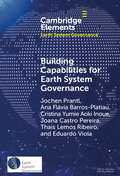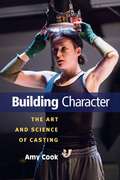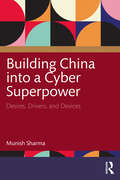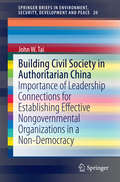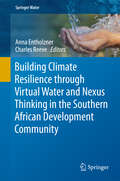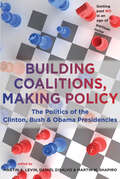- Table View
- List View
Building Bridges in European and Human Rights Law: Essays in Honour and Memory of Paul Heim CMG
This unique book, formed as a series of essays in honour of the memory of Paul Heim CMG, the founder of Lincoln's Inn European Group, focusses on the building of bridges between individuals and institutions in European, international, and human rights law. The book features contributions from some of the foremost current or former European and international judges; leading practitioners and officials, each with links to Lincoln's Inn, and former recipients of Lincoln's Inn's dedicated scholarship programmes.The approachable style of the book makes it readily accessible for a wide range of readers including legal scholars, practitioners, students, and those with a general interest in the application of the law and justice in today's interconnected world. Each contribution provides personal reflections and expertise on selected aspects of European and human rights law, and the personal, professional, and technical bridges involved in their development and maintenance, together with insights into their future. The book provides multi-level perspectives on the Court of Justice of the European Union, the EFTA Court, the European Court of Human Rights, and the International Criminal Court, and the interaction of their jurisprudence with domestic law and between themselves, alongside our ever-evolving societies.
Building Business-Government Relations: A Skills Approach
by Montgomery Van Wart Anna NiThis book introduces business-government relations in the institutional context of the United States from a practitioner’s perspective. It provides the historical, descriptive, and comparative accounts of the public and private sectors, the different roles government plays with business, including several conceptual models to understand the social interactions between the two sectors, and various economic policies associated with business. Business-government relations are framed into three different social economic contexts: The sociopolitical arena, in which government’s role as agent of business, interest groups, and government’s limited role as social architect, are introduced. The local economic development, in which government acts as a promoter of, partner with, and buyer from, business. The global market, where government mainly plays a role as promoter of domestic business. In the course of discussion, a set of skills, such as searching government jobs, starting a business, analyzing stakeholders, ethical reasoning, advancing a business agenda, leveraging public resources, contracting with government, interpreting global trends, doing business abroad, and leveraging international resources, are introduced and exercised.
Building Business-Government Relations: A Skills Approach
by Montgomery Van Wart Anna NiThis book introduces business-government relations in the institutional context of the United States from a practitioner’s perspective. It provides the historical, descriptive, and comparative accounts of the public and private sectors, the different roles government plays with business, including several conceptual models to understand the social interactions between the two sectors, and various economic policies associated with business. Business-government relations are framed into three different social economic contexts: The sociopolitical arena, in which government’s role as agent of business, interest groups, and government’s limited role as social architect, are introduced. The local economic development, in which government acts as a promoter of, partner with, and buyer from, business. The global market, where government mainly plays a role as promoter of domestic business. In the course of discussion, a set of skills, such as searching government jobs, starting a business, analyzing stakeholders, ethical reasoning, advancing a business agenda, leveraging public resources, contracting with government, interpreting global trends, doing business abroad, and leveraging international resources, are introduced and exercised.
Building by Local Authorities: The Report of an Inquiry by the Royal Institute of Public Administration
by Elizabeth LaytonOriginally published in 1961, is the report into an investigation of the forms of organization used by local authorities of many varied types, populations and areas for the design and erection of new buildings and the maintenance of existing ones. It discusses the relations between Government departments and local authorities in the control of building design, standards and costs and the part played by Council committees in the control of building operations; it examines the division of functions between Chief Officers responsible for different aspects of building work (architects, engineers, surveyors and housing managers) and studies the use made of private architects and surveyors as well as the scope and organization of direct labour in local authority building.
Building by Local Authorities: The Report of an Inquiry by the Royal Institute of Public Administration
by Elizabeth LaytonOriginally published in 1961, is the report into an investigation of the forms of organization used by local authorities of many varied types, populations and areas for the design and erection of new buildings and the maintenance of existing ones. It discusses the relations between Government departments and local authorities in the control of building design, standards and costs and the part played by Council committees in the control of building operations; it examines the division of functions between Chief Officers responsible for different aspects of building work (architects, engineers, surveyors and housing managers) and studies the use made of private architects and surveyors as well as the scope and organization of direct labour in local authority building.
Building Capabilities for Earth System Governance (Elements in Earth System Governance)
by null Jochen Prantl null Ana Flávia Barros-Platiau null Cristina Yumie Inoue null Joana Castro Pereira null Thais Lemos Ribeiro null Eduardo ViolaThis Element develops a new Strategic Capabilities Framework for studying and steering complex socio-ecological systems. It is driven by the central question of what are the most essential capabilities that ought to be fostered for addressing the fundamental 21st Century environmental challenges and Earth system transformations. The author's objective is to innovate transformative ideas toward better climate and ocean governance that are of interest both to academics and policymakers in the field. Rather than investigating the design and effectiveness of institutions in governing the climate and the oceans, the authors offer an alternative approach starting from the assumption that global governance arrangements must be informed by the capabilities of the communities affected. This Element aims to offer out-of-the-box thinking about capabilities-focused and community-centered frameworks that align multi-level systems of governance with the fundamental challenges of global environmental change. This title is also available as Open Access on Cambridge Core.
Building Capacities to Evaluate Health Inequities: New Directions for Evaluation, Number 154 (J-B PE Single Issue (Program) Evaluation)
by Sanjeev Sridharan Kun Zhao April NakaimaThe World Health Organization defines health inequities as differences in health outcomes that are systematic, avoidable, and unjust; and the result of poor social policies, unfair economic arrangements, and bad politics. This volume describes the role that evaluations can play in addressing health inequities. A key focus is on the types of capacities that need to be built to evaluate inequities.Bringing alive these questions around evaluation capacities are theory and practice studies from China, Chile, and India.This volume: Focuses on inequities in evaluation capacity building initiatives. Argues evaluations can be interventions themselves. Explores how evaluations can have influence in addressing inequities. Recognizes that innovations in evaluation capacity experiments are occurring in diverse countries and we have the opportunity to learn from such initiatives. This is the 154th issue in the New Directions for Evaluation series from Jossey-Bass. It is an official publication of the American Evaluation Association.
Building Capacities to Evaluate Health Inequities: New Directions for Evaluation, Number 154 (J-B PE Single Issue (Program) Evaluation)
by Sanjeev Sridharan Kun Zhao April NakaimaThe World Health Organization defines health inequities as differences in health outcomes that are systematic, avoidable, and unjust; and the result of poor social policies, unfair economic arrangements, and bad politics. This volume describes the role that evaluations can play in addressing health inequities. A key focus is on the types of capacities that need to be built to evaluate inequities.Bringing alive these questions around evaluation capacities are theory and practice studies from China, Chile, and India.This volume: Focuses on inequities in evaluation capacity building initiatives. Argues evaluations can be interventions themselves. Explores how evaluations can have influence in addressing inequities. Recognizes that innovations in evaluation capacity experiments are occurring in diverse countries and we have the opportunity to learn from such initiatives. This is the 154th issue in the New Directions for Evaluation series from Jossey-Bass. It is an official publication of the American Evaluation Association.
Building Capacity in Institutional Research and Decision Support in Higher Education (Knowledge Studies in Higher Education #4)
by Karen L. WebberThis book examines the relevant roles, skills and knowledge needed to build the institutional research capacity across the higher education sector globally. The information contained herein will inform IR practitioners, senior level institution officials, and higher education scholars. With a focus on building the capacity of the IR profession, this book’s primary audiences include senior leaders who wish to introduce or strengthen their understanding for effective decision support and staff members who are currently in decision support units and those who wish to serve in this capacity. However, this book also offers detail on the decision support function to higher education scholars who seek to better address how data can inform policy and planning in higher education. Through a broad discussion about the roles and skills of the practitioners, this book will also enumerate the ways in which decision support practitioners can be valued contributors in shaping the future decisions and direction of specific institutions and higher education broadly.
Building Character: The Art and Science of Casting
by Amy CookWhat can we learn about how we understand each other and ourselves by examining the casting we find on stage and film—the casting we find perfect and the casting we find wrong? Building Character examines how the process of “casting” an actor in a part creates a character and how this can be usefully understood through deploying theories from the cognitive sciences. A casting director may match the perceived qualities of an actor with the perceived qualities of the character, but the combination is also synergistic; casting a character creates qualities. While casting directors do this professionally, all of us do this when we make sense of the people around us. This book argues that we build the characters of others from a sea of stimuli and that the process of watching actors take on roles improves our ability to “cast” those roles in our daily lives. Amy Cook examines the visible celebrity casting, such as Robert Downey Jr. as Ironman or Judi Dench as Bond’s M, the political casting of one candidate as “presidential” and another as “weak,” the miscasting of racial profiling and sexual assault, and the counter casting that results when actors and characters are not where or who we expect.
Building China: Informal Work and the New Precariat
by Sarah SwiderRoughly 260 million workers in China have participated in a mass migration of peasants moving into the cities, and construction workers account for almost half of them. In Building China, Sarah Swider draws on her research in Beijing, Guangzhou, and Shanghai between 2004 and 2012, including living in an enclave, working on construction jobsites, and interviews with eighty-three migrants, managers, and labor contractors. This ethnography focuses on the lives, work, family, and social relations of construction workers. It adds to our understanding of China’s new working class, the deepening rural-urban divide, and the growing number of undocumented migrants working outside the protection of labor laws and regulation. Swider shows how these migrants—members of the global "precariat," an emergent social force based on vulnerability, insecurity, and uncertainty—are changing China’s class structure and what this means for the prospects for an independent labor movement.The workers who build and serve Chinese cities, along with those who produce goods for the world to consume, are mostly migrant workers. They, or their parents, grew up in the countryside; they are farmers who left the fields and migrated to the cities to find work. Informal workers—who represent a large segment of the emerging workforce—do not fit the traditional model of industrial wage workers. Although they have not been incorporated into the new legal framework that helps define and legitimize China’s decentralized legal authoritarian regime, they have emerged as a central component of China’s economic success and an important source of labor resistance.
Building China into a Cyber Superpower: Desires, Drivers, and Devices
by Munish SharmaThis book provides a comprehensive look into China’s emerging cyberspace strategy. It highlights the prime drivers of China’s desire to be a cyber superpower and discusses the ways in which China is turning resources into cyber power.The book analyses China’s domestic cyber policy initiatives, strategy documents, censorship measures, and the rationale behind its strong advocacy for sovereignty in cyberspace. It examines China’s position on the prominent issues of cyberspace governance, norms and security in cyberspace, and key diplomatic initiatives. The book also discusses next-generation networks, artificial intelligence, quantum information sciences, and cyber warfare.An important contribution to the study of China’s cyber policy, the book will be of interest to students and researchers of international relations,Chinese digitalisation, security studies, Chinese politics, international security, Chinese foreign policy, and Chinese economy. It will also be useful to the policymakers and corporate professionals engaged with China’s digital sphere.
Building China into a Cyber Superpower: Desires, Drivers, and Devices
by Munish SharmaThis book provides a comprehensive look into China’s emerging cyberspace strategy. It highlights the prime drivers of China’s desire to be a cyber superpower and discusses the ways in which China is turning resources into cyber power.The book analyses China’s domestic cyber policy initiatives, strategy documents, censorship measures, and the rationale behind its strong advocacy for sovereignty in cyberspace. It examines China’s position on the prominent issues of cyberspace governance, norms and security in cyberspace, and key diplomatic initiatives. The book also discusses next-generation networks, artificial intelligence, quantum information sciences, and cyber warfare.An important contribution to the study of China’s cyber policy, the book will be of interest to students and researchers of international relations,Chinese digitalisation, security studies, Chinese politics, international security, Chinese foreign policy, and Chinese economy. It will also be useful to the policymakers and corporate professionals engaged with China’s digital sphere.
Building Cities to LAST: A Practical Guide to Sustainable Urbanism
by Jassen CallenderBuilding Cities to LAST presents the myriad issues of sustainable urbanism in a clear and concise system, and supports holistic thinking about sustainable development in urban environments by providing four broad measures of urban sustainability that differ radically from other, less long-lived patterns: these are Lifecycle, Aesthetics, Scale, and Technology (LAST). This framework for understanding the relationship between these four measures and the essential types of infrastructure—grouped according to the basic human needs of Food, Shelter, Mobility, and Water—is laid out in a simple and easy-to-understand format. These broad measures and infrastructures address the city as a whole and as a recognizable pattern of human activity and, in turn, increase the ability of cities—and the human race—to LAST. This book will find wide readership particularly among students and young practitioners in architecture, urban planning, and landscape architecture.
Building Cities to LAST: A Practical Guide to Sustainable Urbanism
by Jassen CallenderBuilding Cities to LAST presents the myriad issues of sustainable urbanism in a clear and concise system, and supports holistic thinking about sustainable development in urban environments by providing four broad measures of urban sustainability that differ radically from other, less long-lived patterns: these are Lifecycle, Aesthetics, Scale, and Technology (LAST). This framework for understanding the relationship between these four measures and the essential types of infrastructure—grouped according to the basic human needs of Food, Shelter, Mobility, and Water—is laid out in a simple and easy-to-understand format. These broad measures and infrastructures address the city as a whole and as a recognizable pattern of human activity and, in turn, increase the ability of cities—and the human race—to LAST. This book will find wide readership particularly among students and young practitioners in architecture, urban planning, and landscape architecture.
Building Citizenship from Below: Precarity, Migration, and Agency
by Marcel Paret Shannon GleesonFocusing on what can be referred to as the ‘precarity-agency-migration nexus’, this comprehensive volume leverages the political, economic, and social dynamics of migration to better understand both deepening inequality and popular resistance. Drawing on rich ethnographic and interview-based studies of the United States and Latin America, the authors show how migrants are navigating and challenging conditions of insecurity and structures of power. Detailed case studies illuminate collective survival strategies along the migrant trail, efforts by nannies and dairy workers in the northeast United States to assert dignity and avoid deportation, strategies of reintegration used by deportees in Guatemala and Mexico, and grassroots organizing and public protest in California. In doing so they reveal varied moments of agency without presenting an overly idyllic picture or presuming limitless potential for change. Anchoring the study of migration in the opposition between precarity and agency, the authors thus provide a new window into the continuously unfolding relationship between national borders, global capitalism, and human freedom. This book was originally published as a special issue of the journal Citizenship Studies.
Building Citizenship from Below: Precarity, Migration, and Agency
by Marcel Paret Shannon GleesonFocusing on what can be referred to as the ‘precarity-agency-migration nexus’, this comprehensive volume leverages the political, economic, and social dynamics of migration to better understand both deepening inequality and popular resistance. Drawing on rich ethnographic and interview-based studies of the United States and Latin America, the authors show how migrants are navigating and challenging conditions of insecurity and structures of power. Detailed case studies illuminate collective survival strategies along the migrant trail, efforts by nannies and dairy workers in the northeast United States to assert dignity and avoid deportation, strategies of reintegration used by deportees in Guatemala and Mexico, and grassroots organizing and public protest in California. In doing so they reveal varied moments of agency without presenting an overly idyllic picture or presuming limitless potential for change. Anchoring the study of migration in the opposition between precarity and agency, the authors thus provide a new window into the continuously unfolding relationship between national borders, global capitalism, and human freedom. This book was originally published as a special issue of the journal Citizenship Studies.
Building Civil Society in Authoritarian China: Importance of Leadership Connections for Establishing Effective Nongovernmental Organizations in a Non-Democracy (SpringerBriefs in Environment, Security, Development and Peace #20)
by John W. TaiHow is modern civil society created? There are few contemporary studies on this important question and when it is addressed, scholars tend to emphasize the institutional environment that facilitates a modern civil society. However, there is a need for a new perspective on this issue. Contemporary China, where a modern civil society remains in a nascent stage, offers a valuable site to seek new answers. Through a comparative analysis of nongovernmental organizations (NGOs) in today’s China, this study shows the importance of the human factor, notably the NGO leadership, in the establishment of a modern civil society. In particular, in recognition of the social nature of NGOs, this study engages in a comparative examination of Chinese NGO leaders’ state linkage, media connections and international ties in order to better understand how each factor contributes to effective NGOs.
Building Climate Resilience through Virtual Water and Nexus Thinking in the Southern African Development Community (Springer Water)
by Anna Entholzner Charles ReeveThis book puts the spotlight on Southern Africa, presenting a cutting-edge concept never previously explored in the context of climate change and putting forward arguments for regional integration and cooperation. The Climate Resilient Infrastructure Development Facility (CRIDF) is the new water infrastructure program of the UK Department for International Development (DFID) for Southern Africa. The CRIDF promotes the establishment of small to medium-scale infrastructure across the Southern African Development Community (SADC) through technical assistance aimed at developing sustainable pro-poor projects, while also facilitating access to the financial resources needed to deliver said infrastructure. Further, it focuses on regional water resource management goals and basin plans, as well as on building climate resilience for the beneficiary communities. The Facility’s Virtual Water and Nexus Project works to improve regional peace dividends by translating the Nexus concept into national and regional policies; it ultimately promotes sovereign security through greater regional integration across the water, food and energy sectors, while taking into account potential benefits in connection with carbon sequestration and emission mitigation.
Building Coalitions, Making Policy: The Politics of the Clinton, Bush, and Obama Presidencies
by Martin A. Levin Daniel DiSalvo Martin M. ShapiroIn an age when partisan politics has reached a deafening—and arguably impotent—pitch, how does the real work of politics get done? This book opens the door on backroom politics and gives readers an insider's perspective on the efforts of policymakers from three presidential administrations to get past the naysayers and effect real and lasting policy changes.The editors take a comparative approach, offering a thorough overview of policymaking during the Clinton and George W. Bush administrations, with further discussion of President Obama's successful and failed attempts to build coalitions and get past no. The contributors, a national network of prominent political scientists, reveal the sausage-making of politics and policy. Readers can almost see the political players in the proverbial smoke-filled room, shirtsleeves rolled up and BlackBerrys in hand, developing the strategies and hammering out the compromises designed to hold the party base while winning over independent voters. Combining an insider's perspective with actual case studies, the volume examines the policymaking behind such programs as• No Child Left Behind• tax cuts• Social Security privatization• Medicare prescription drug reform• education and immigration reform• environmental policy• judicial politics• national securityCovering all major areas of policymaking, Building Coalitions, Making Policy gives instructors in political science, public administration and policy, American government, and American presidential studies plenty of provocative examples for classroom debate.
Building Coalitions, Making Policy: The Politics of the Clinton, Bush, and Obama Presidencies
by Martin A. Levin Daniel DiSalvo Martin M. ShapiroIn an age when partisan politics has reached a deafening—and arguably impotent—pitch, how does the real work of politics get done? This book opens the door on backroom politics and gives readers an insider's perspective on the efforts of policymakers from three presidential administrations to get past the naysayers and effect real and lasting policy changes.The editors take a comparative approach, offering a thorough overview of policymaking during the Clinton and George W. Bush administrations, with further discussion of President Obama's successful and failed attempts to build coalitions and get past no. The contributors, a national network of prominent political scientists, reveal the sausage-making of politics and policy. Readers can almost see the political players in the proverbial smoke-filled room, shirtsleeves rolled up and BlackBerrys in hand, developing the strategies and hammering out the compromises designed to hold the party base while winning over independent voters. Combining an insider's perspective with actual case studies, the volume examines the policymaking behind such programs as• No Child Left Behind• tax cuts• Social Security privatization• Medicare prescription drug reform• education and immigration reform• environmental policy• judicial politics• national securityCovering all major areas of policymaking, Building Coalitions, Making Policy gives instructors in political science, public administration and policy, American government, and American presidential studies plenty of provocative examples for classroom debate.
Building Community Capacity
by Avis VidalThis book focuses on a gap in current social work practice theory: community change. Much work in this area of macro practice, particularly around ""grassroots"" community organizing, has a somewhat dated feel to it, is highly ideological in orientation, or suffers from superficiality, particularly in the area of theory and practical application. Set against the context of an often narrowly constructed ""clinical"" emphasis on practice education, coupled with social work's own current rendering of ""scientific management,"" community practice often takes second or third billing in many professional curricula despite its deep roots in the overall field of social welfare.Drawing on extensive case study data from three significant community-building initiatives, program data from numerous other community capacity-building efforts, key informant interviews, and an excellent literature review, Chaskin and his colleagues draw implications for crafting community change strategies as well as for creating and sustaining the organizational infrastructure necessary to support them. The authors bring to bear the perspectives of a variety of professional disciplines including sociology, urban planning, psychology, and social work.Building Community Capacity takes a collaborative, interdisciplinary approach to a subject of wide and current concern: the role of neighborhood and community structures in the delivery of human services or, as the authors put it, ""a place where programs and problems can be fitted together."" Social work scholars and students of community practice seeking new conceptual frameworks and insights from research to inform novel community interventions will find much of value in Building Community Capacity.
Building Community Capacity
by Avis VidalThis book focuses on a gap in current social work practice theory: community change. Much work in this area of macro practice, particularly around ""grassroots"" community organizing, has a somewhat dated feel to it, is highly ideological in orientation, or suffers from superficiality, particularly in the area of theory and practical application. Set against the context of an often narrowly constructed ""clinical"" emphasis on practice education, coupled with social work's own current rendering of ""scientific management,"" community practice often takes second or third billing in many professional curricula despite its deep roots in the overall field of social welfare.Drawing on extensive case study data from three significant community-building initiatives, program data from numerous other community capacity-building efforts, key informant interviews, and an excellent literature review, Chaskin and his colleagues draw implications for crafting community change strategies as well as for creating and sustaining the organizational infrastructure necessary to support them. The authors bring to bear the perspectives of a variety of professional disciplines including sociology, urban planning, psychology, and social work.Building Community Capacity takes a collaborative, interdisciplinary approach to a subject of wide and current concern: the role of neighborhood and community structures in the delivery of human services or, as the authors put it, ""a place where programs and problems can be fitted together."" Social work scholars and students of community practice seeking new conceptual frameworks and insights from research to inform novel community interventions will find much of value in Building Community Capacity.
Building Complex Temporal Explanations of Crime: History, Institutions and Agency (Critical Criminological Perspectives)
by Stephen FarrallThis book seeks to bring understanding of both complexity and temporality into criminology. It outlines why these are important in criminological models of causation and explanation and explores them by drawing on theories and approaches in political science, comparative history, social theory and systems analyses. It discusses what is meant by complexity and introduces historical institutionalism (which is rarely used in criminology) to criminological audiences; it introduces what is known as ‘why-because’ analyses to the social sciences. This style of thinking is used to explore the causes of major transportation accidents (such as aeroplane or ferry disasters) and involves the integration of structural, organisational and agentic inputs in accounting for such disasters. Chapters on realistic evaluation, theories of structuration and agency, and research design and research methods are included with an example project based on the author's recent studies of Thatcherism which shows how these theories can be applied to empirical data. This book speaks to those interested in criminology, sociology, political science, research methods and the wider social sciences.
Building Constitutionalism in China (The Sciences Po Series in International Relations and Political Economy)
by Michael W. Dowdle S. BalmeThis volume unpacks the relationship between constitutionalism and judicial power in China. It explores how court behaviour intersects with - affects and is affected by - China's evolving notions of constitutionalism.



